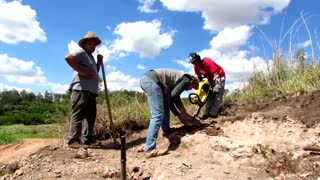Premium Only Content

New Dinosaur Species That Lived In Greenland Over 200 Million Years Ago Named Cold Bone
This 13-foot-long dinosaur whose fossilised remains were unearthed under the freezing ice sheets of Greenland has earned the name 'Cold bone' in tribute to the location's Inuit people.
The dinosaur's scientific name 'Issi saaneq' was chosen in tribute to Greenland's Inuit language and is translated roughly to 'Cold bone'.
Despite its size, Cold bone was a herbivore and an ancestor of the diplodocus which is one of the most famous dinosaurs due to its incredibly long neck.
According to a statement released by Martin Luther University of Halle-Wittenberg (MLU), in the German state of Saxony-Anhalt, yesterday, 8th November, the two-legged herbivore lived in what is today Greenland 214 million years ago.
Cold bone is believed to have weighed up to one tonne and was unearthed by a group of researchers from Germany, Denmark and Portugal.
The first clues of Cold bone's existence emerged in 1994 when Harvard scientists working in eastern Greenland found a pair of skulls.
However, its existence was not confirmed until the results of CT scans on the skulls were published in a paper titled 'A New Sauropodomorph Dinosaur from the Late Triassic (Norian) of Jameson Land, Central East Greenland' in the journal Diversity on 3rd November.
Dr Oliver Wings of MLU, co-author of the study, said that it was a particularly exciting discovery because Cold bone is closely related to the famous Plateosaurus.
The CT scan created a digital model of the skulls clearly showing their internal structures, as seen in the video.
Victor Beccari, the paper's lead author, said that the skulls have a unique structure in terms of their shapes and proportions, proving that they come from a new species.
According to the study, the new species belongs to a long-necked group of dinosaurs known as sauropodomorphs.
The sauropodomorph family includes the diplodocus, which was the largest land animal ever to live on Earth.
When Cold bone roamed Greenland in the Late Triassic Period, the landmass was not the largely uninhabitable icy world that it is today.
During this period, there was a diverse and rich ecosystem in the region with plenty of greenery to keep Cold bone and other dinosaurs fed.
The Late Triassic was a period of change during which the Pangaea supercontinent diverged and the Atlantic Ocean was formed.
This change in the world's geography allowed plant-eating dinosaurs to reach Europe for the first time, said Professor Lars Clemmensen.
Cold bone marks the first proof of a recognisable Greenlandic species of dinosaurs and represents an addition to the already diverse number of species identified from the Late Triassic period.
Once the analysis of the skulls is completed, they are expected to be moved to the Natural History Museum of Denmark.
Victor Beccari/NF/Peter Barker
-
 2:14
2:14
Viral Tab Animals
2 years agoSix Rorquals Including Mum And Calf Spotted Off Spanish Coast
62 -
 1:06
1:06
Reuters
3 years agoNew dinosaur species identified in Brazil
3659 -
 0:15
0:15
WFTS
3 years agoCOVID-19's global death toll tops 5 million in under 2 years
331 -
 1:02
1:02
AfricanNewsAgency
3 years agoSA administers 12 million vaccines, over 7 700 new cases
16 -
 4:21
4:21
FamilyFriendlyGaming
4 years agoFFG Chronicles Over 1 million again
50 -
 2:51
2:51
WGBA
4 years agoSome surprising Olympic games that have been eliminated over the years
16 -
 3:12:37
3:12:37
IsaiahLCarter
1 day ago $1.69 earnedJonah O. Wheeler: In Defense of Reality || APOSTATE RADIO #026
31.4K1 -
 LIVE
LIVE
Cewpins
6 hours agoSmoke Sesh🔥Gaming???💨420🍃!MJ !giveaway
158 watching -
 LIVE
LIVE
Phyxicx
5 hours agoShin Megami Tensei - Part 5 - 8/13/2025 | Chaos Route | Expert Difficulty
90 watching -
 1:59:32
1:59:32
vivafrei
15 hours agoEp. 277: Russia Peace Talks! Trump D.C. Takeover Leads to Lawsuit! Heat Wave Lawsuit? AND MORE!
84.5K116